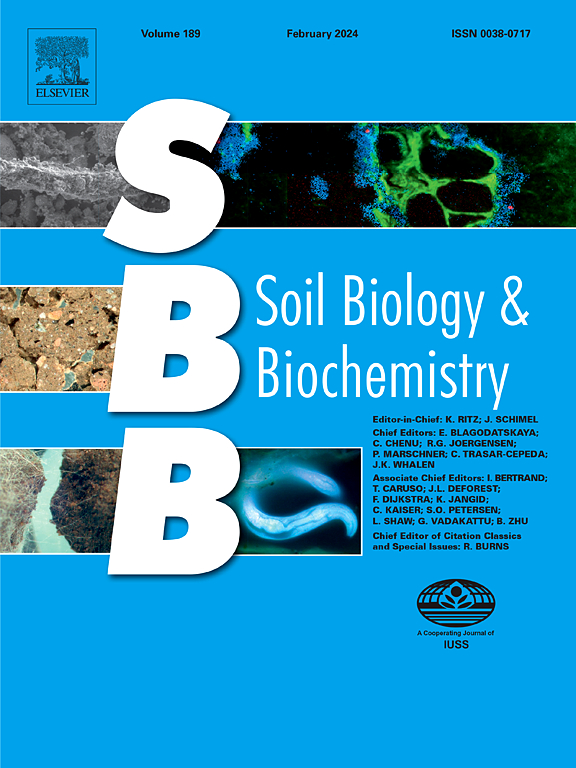Organic cropping systems alter metabolic potential and carbon, nitrogen and phosphorus cycling capacity of soil microbial communities
IF 9.8
1区 农林科学
Q1 SOIL SCIENCE
引用次数: 0
Abstract
Intensive agriculture can impair soil quality and threaten the provision of critical soil ecosystem services. Organic cropping systems aim to ensure sustainable production by promoting soil biodiversity to enhance soil functioning and regulate nutrient cycling through microbial processes. While taxonomic changes in microbial community composition in response to agricultural management are well described, there is still a fundamental knowledge gap when it comes to the impact of cropping system on soil functional diversity. Therefore, we revisited the 42-year-old DOK field experiment and used shotgun metagenomics to assess the metabolic potential and nutrient cycling capacities in organic and conventionally managed soils. The functional annotation of 11.4 billion reads to universal (EC, SEED), as well as carbon (CAZy), nitrogen (NCycDB) and phosphorus (PCycDB) cycling gene ontologies showed that manure fertilization was the main factor altering soil metabolic potential. But also, organic management practices, such as omission of synthetic pesticides and mineral fertilization induced changes in soil metabolic potential e.g. by enriching functional genes involved in organic phosphorus acquisition, nitrate transformation, organic degradation and non-hydrolytic carbohydrate cleavage. Conventional systems, receiving mineral fertilization and chemical plant protection, enriched genes associated with inorganic nutrient acquisition and transcriptional activity. The results of this study demonstrate that cropping systems influence the functional potential of soils, affecting fundamental mechanisms of nutrient cycling and thus soil regulating capacity. Consequently, cropping systems can be utilized to steer the regulating potential of agricultural soils and to lower the environmental impact of food systems.
有机种植制度改变了土壤微生物群落的代谢潜能和碳、氮、磷循环能力
集约化农业会损害土壤质量,并威胁到关键土壤生态系统服务的提供。有机种植系统旨在通过促进土壤生物多样性、增强土壤功能和通过微生物过程调节养分循环来确保可持续生产。虽然微生物群落组成的分类学变化对农业管理的响应得到了很好的描述,但当涉及到种植制度对土壤功能多样性的影响时,仍然存在基本的知识空白。因此,我们重新审视了42年前的DOK田间试验,并使用霰弹枪宏基因组学来评估有机和常规管理土壤的代谢潜力和养分循环能力。对通用(EC, SEED)以及碳(CAZy)、氮(NCycDB)和磷(PCycDB)循环基因本体的114亿个reads的功能注释表明,肥料施肥是改变土壤代谢势的主要因素。此外,有机管理措施,如不施用合成农药和不施用矿物肥料,通过丰富参与有机磷获取、硝酸盐转化、有机降解和非水解碳水化合物裂解的功能基因,引起了土壤代谢潜力的变化。接受矿物施肥和化学植物保护的常规系统,富集了与无机养分获取和转录活性相关的基因。研究结果表明,种植制度影响土壤的功能潜能,影响养分循环的基本机制,从而影响土壤的调节能力。因此,可以利用种植制度来引导农业土壤的调节潜力,并降低粮食系统对环境的影响。
本文章由计算机程序翻译,如有差异,请以英文原文为准。
求助全文
约1分钟内获得全文
求助全文
来源期刊

Soil Biology & Biochemistry
农林科学-土壤科学
CiteScore
16.90
自引率
9.30%
发文量
312
审稿时长
49 days
期刊介绍:
Soil Biology & Biochemistry publishes original research articles of international significance focusing on biological processes in soil and their applications to soil and environmental quality. Major topics include the ecology and biochemical processes of soil organisms, their effects on the environment, and interactions with plants. The journal also welcomes state-of-the-art reviews and discussions on contemporary research in soil biology and biochemistry.
 求助内容:
求助内容: 应助结果提醒方式:
应助结果提醒方式:


